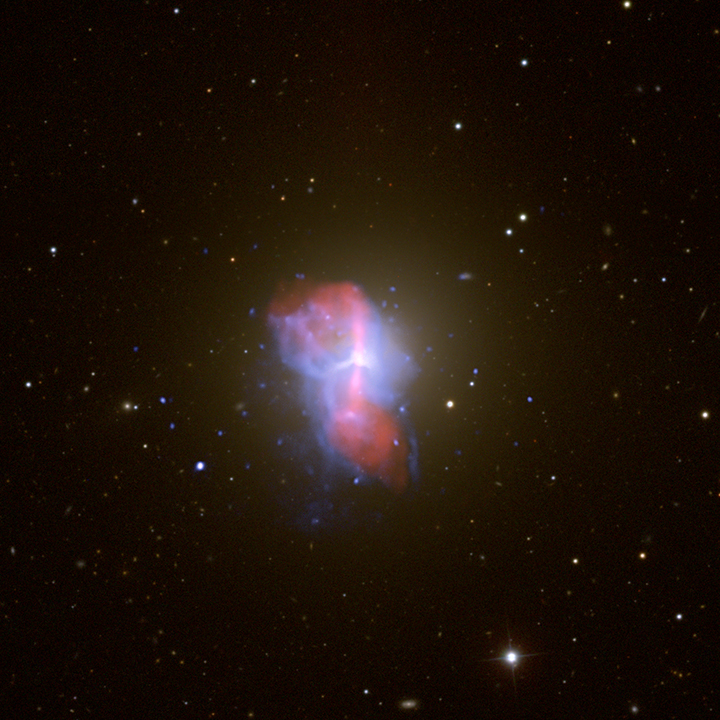[/caption]
Obviously, today is the day for news on black holes. While one group of astronomers studied the violent flares of energy sent out by black holes in the near infrared and submillimeter wavelengths, another group used the Chandra X-Ray Observatory to see how black holes can pump energy in a gentler and rhythmic fashion, rather than violently. These scientists say the powerful black holes at the center of massive galaxies act as hearts to the systems, pumping energy out at regular intervals to regulate the growth of the black holes themselves, as well as star formation. “Just like our hearts periodically pump our circulatory systems to keep us alive, black holes give galaxies a vital warm component. They are a careful creation of nature, allowing a galaxy to maintain a fragile equilibrium,” said Alexis Finoguenov, of the Max-Planck Institute for Extraterrestrial Physics in Germany.
The scientists observed and simulated how the black hole at the center of elliptical galaxy M84 dependably sends bubbles of hot plasma into space, heating up interstellar space.
Here’s an animation of the regular pulses of bubbles.
This heat is believed to slow both the formation of new stars and the growth of the black hole itself, helping the galaxy remain stable. Interstellar gases only coalesce into new stars when the gas is cool enough. The heating is more efficient at the sites where it is most needed, the scientists say.
This finding helps to explain a decades-long paradox of the existence of large amounts of warm gas around certain galaxies, making them appear bright to the Chandra X-ray telescope.
“For decades astronomers were puzzled by the presence of the warm gas around these objects. The gas was expected to cool down and form a lot of stars” said Mateusz Ruszkowski, an assistant professor in the University of Michigan Department of Astronomy.
“Now, we see clear and direct evidence that the heating mechanism of black holes is persistent, producing enough heat to significantly suppress star formation. These plasma bubbles are caused by bursts of energy that happen one after another rather than occasionally, and the direct evidence for such periodic behavior is difficult to find.”
The bubbles form one inside another, for a sort of Russian doll effect that has not been seen before, Ruszkowski said. One of the bubbles of hot plasma appears to be bursting and its contents spilling out, further contributing to the heating of the interstellar gas.
“Disturbed gas in old galaxies is seen in many images that NASA’s Chandra observatory obtained, but seeing multiple events is a really impressive evidence for persistent black hole activity,” says Christine Jones, an astrophysicist at the Harvard-Smithsonian Center for Astrophysics.
A paper on the research called “In-depth Chandra study of the AGN feedback in Virgo Elliptical Galaxy M84” has been published in Astrophysical Journal.
Source: University of Michigan


So blackhole’s burp!
Thats cool..
It’s the anthropic principle. It is because it is, and if it was not, then we wouldn’t be hear to not know about it.
I’m confused, which is not unusual, but this article states that the gentle and rhythmic fluctuations of black holes heat the galaxy whereas the next article states that the violent flares result simply in hot gases being stretched around the black hole since they do not obtain escape velocity. Does this seem to be contradictory?
Joe
Can you say “resonant electric circuit”?
No… but I’ll be sure to look it up.
Thanks for the info.
Joe
Where does this gas come from? Stars?
I like that the big demon at the centre of galaxies does do good things too. Eqilibrium makes sense, otherwise we might all end up with a lot less time to enjoy.
one more reason to be fascinated by these strange objects.
Joe,
Gentler probably wasn’t the best choice of words, but what is meant by this, is the energy released in this fashion is rhythmic and predictable… instead of just sporadic, unknown and unpredictable. If you were anywhere near it without knowledge of how it works you certainly would believe it was something violent, since a huge amount of energy is being ‘pumped’ out.
True once something is within the event horizon of a black hole, it isn’t escaping. However, the black hole itself does resonate a lot of energy away from itself, some things moving near the speed of light. Since it is from the power of the black hole itself, it is able to boost it outside of its own event horizon and out to space… which displays just how energetic and powerful a super massive black hole is.
thanks for the thoughful reply…
How does slowing the formation of new stars help to stabilize a galaxy? Is it that too many stars forming too rapidly crowd up, or expend the galactic well far too quickly?
Yes, exactly. And without getting too technical, I’d point to Hollywood as the best example of your explanation.